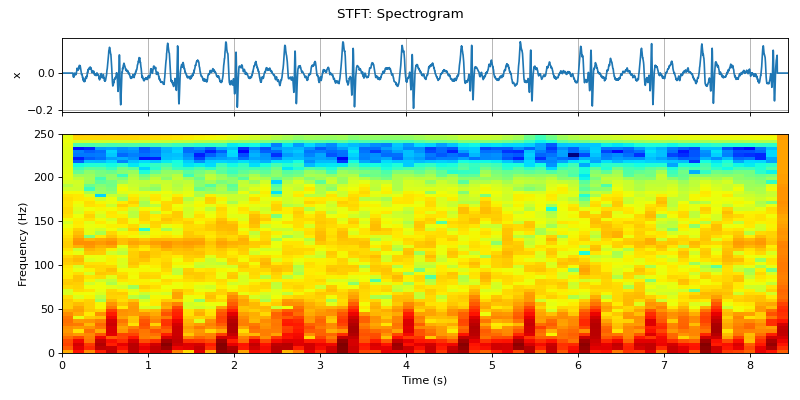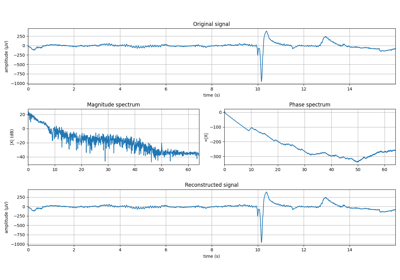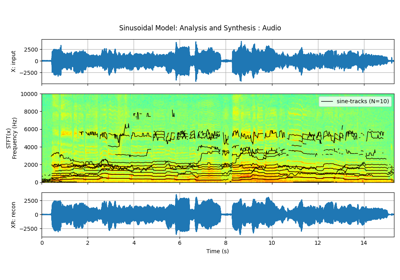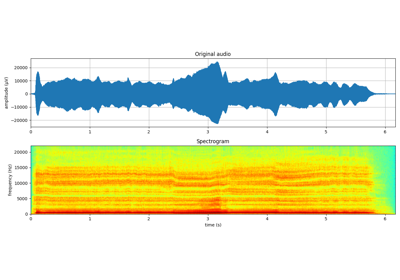spkit.stft_analysis¶
- spkit.stft_analysis(x, winlen, window='blackmanharris', nfft=None, overlap=None, plot=False, fs=1, interpolation=None, figsize=(10, 5))¶
Short-Time Fourier Transform Analysis Model
Analysis of a signal using the Short-Time Fourier Transform
- Parameters:
- x: 1d-array
signal - shape (n,)
- winlenint,
window length for analysis (good choice is a odd number)
window size is chosen based on the frequency resolution required
winlen >= Bs*fs/del_f
where Bs=4 for hamming window, Bs=6 for blackman harris
def_f is different between two frequecies (to be resolve)
higher the window length better the frequency resolution, but poor time resolution
- overlap: int, default = None
overlap of windows
if None then winlen//2 is used (50% overlap)
shorter overlap can improve time resoltion - upto an extend
- window: str, default = blackmanharris
analysis window
if None, rectangular window is used
- nfft: int,
FFT size, should be >=winlen and power of 2
if None - nfft = 2**np.ceil(np.log2(len(n)))
- plot: bool, (default: False)
False, for no plot
True for plot
- fsint, deafult=None
sampling frequency, only used for plots
if not provided, fs=1 is used
it does not affect any computations
- interpolation: str, default=None, {‘bilinear’, ‘sinc’, ..}
interpolation applied to plot
it does not affect any computations
- figsize: figure-size
- Returns:
- mXt2d-array,
magnitude spectra of shape (number of frames, int((nfft/2)+1))
- pXt2d-array,
phase spectra of same shape as mXt
See also
stft_synthesisInverse Short-Time Fourier Transform - iSTFT
dft_analysisDiscreet Fourier Transform - DFT
dft_synthesisInverse Discreet Fourier Transform - iDFT
frftFractional Frourier Transform - FRFT
ifrftInverse Fractional Frourier Transform - iFRFT
sineModel_analysisSinasodal Model Decomposition
sineModel_synthesisSinasodal Model Synthesis
Examples
#sp.stft_analysis import numpy as np import matplotlib.pyplot as plt import spkit as sp x,fs,lead_names = sp.data.ecg_sample_12leads(sample=2) x = x[:int(fs*10),5] x = sp.filterDC_sGolay(x, window_length=fs//3+1) t = np.arange(len(x))/fs mXt, pXt = sp.stft_analysis(x,winlen=127) fig, (ax1, ax2) = plt.subplots(2, 1, gridspec_kw={'height_ratios': [1, 3]},figsize=(10,5)) ax1.plot(t,x) ax1.set_xlim([t[0],t[-1]]) ax1.set_ylabel('x') ax1.grid() ax1.set_xticklabels('') ax2.imshow(mXt.T,aspect='auto',origin='lower',cmap='jet',extent=[t[0],t[-1],0,fs/2],interpolation='bilinear') ax2.set_ylabel('Frequency (Hz)') ax2.set_xlabel('Time (s)') fig.suptitle('Spectrogram') plt.tight_layout() plt.show()
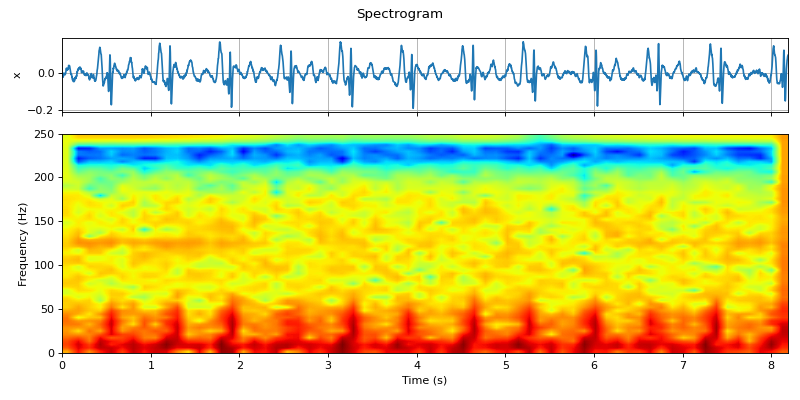
##################### #sp.stft_analysis import numpy as np import matplotlib.pyplot as plt import spkit as sp x,fs,lead_names = sp.data.ecg_sample_12leads(sample=2) x = x[:int(fs*10),5] x = sp.filterDC_sGolay(x, window_length=fs//3+1) t = np.arange(len(x))/fs mXt, pXt = sp.stft_analysis(x,winlen=127,plot=True, fs=fs)
